(Press-News.org) Professor Richard Lilford and Dr Yen-Fu Chen of the University's Warwick Medical School, raised the issue following a study that states hospital weekend death risk is common in several developed countries - not just England
Professor Lilford, said: "Understanding this is an extremely important task since it is large, at about 10% in relative risk terms and 0.4% in percentage point terms. This amounts to about 160 additional deaths in a hospital with 40,000 discharges per year.
"But how much of the observed increase results from service failure? And here is the rub, for while a 0.4 percentage point represents a large, potentially scandalous, number of deaths, it is quite a small proportional change".
The experts from the University of Warwick wrote an editorial linked to a paper, The Global Comparators project: international comparison of 30-day in-hospital mortality by day of the week, which was published online in BMJ Quality & Safety.
The authors of the editorial, The ubiquitous weekend effect: moving past proving it exists to clarifying what causes it, believe that there should be more focus on finding the causes behind the 'weekend effect' rather than just proving its existence.
The research found that the heightened risk of death after admission to hospital at the weekend--the so-called 'weekend effect'--is a feature of several developed countries' healthcare systems, and not just a problem for hospitals in England. The international nature of the findings suggests that this is a phenomenon that not only crosses time, but also geography.
The researchers who conducted the study looked at data on almost three million admissions between 2009 and 2012 from 28 metropolitan teaching hospitals in England, Australia, USA and The Netherlands.
They focused on deaths occurring in hospital within 30 days of an emergency admission or elective surgery.
They found that, after taking account of influential factors, the risk of dying within 30 days was higher for emergency admissions at weekends for 22 of the 28 hospitals.
This risk was 8% higher in 11 hospitals in England, 13% higher in five of the US hospitals, and 20% higher in six Dutch hospitals.
There was no daily variation in the heightened risk of death after 30 days for emergency admissions at weekends in the Australian hospitals, and these hospitals between them had the largest proportion of emergency admissions. But those admitted on a Saturday were 12% more likely to die within seven days.
And all patients admitted at the weekend for elective surgery were more likely to die within 30 days across the board than those admitted on other days of the week, the findings showed.
The researchers of the study speculate on the reasons for the findings, pointing out that no one single factor is going to be responsible.
They suggest that certain diagnoses and procedures may be particularly sensitive to reduced access to test results and diagnostics at weekends. Similarly, weekend staff may be fewer in number and less experienced, while patients requiring urgent care may have to wait longer, which might affect the success of any treatment and interventions.
Professor Lilford and Dr Chen were asked to write provide expert comment due to their work on a project to evaluate NHS England's policy drive for seven-day services. Called HiSLAC it examines the intensity of specialist-led care of emergency medical admissions, with a particular focus on weekend provision.
In collaboration with the University of Birmingham they will aim to understand factors likely to impede or enhance the effectiveness of the change in practice.
INFORMATION:
This news release is available in German.
Jülich, 7 July - Using a single molecule as a sensor, scientists in Jülich have successfully imaged electric potential fields with unrivalled precision. The ultrahigh-resolution images provide information on the distribution of charges in the electron shells of single molecules and even atoms. The 3D technique is also contact-free. The first results achieved using "scanning quantum dot microscopy" have been published in the current issue of Physical Review Letters. The related publication was chosen as ...
A yearlong study of first-time smartphone users by researchers at Rice University and the U.S. Air Force found that users felt smartphones were actually detrimental to their ability to learn.
The research paper "You Can Lead a Horse to Water But You Cannot Make Him Learn: Smartphone Use in Higher Education" appeared in a recent edition of the British Journal of Educational Technology. The research reveals the self-rated impact of smartphones among the users.
"Smartphone technology is penetrating world markets and becoming abundant in most college settings," said Philip ...
Today in Nature Communications, scientists at the Institute for Research in Biomedicine (IRB Barcelona) provide molecular details about Seckel Syndrome, a rare disease that causes microcephaly, or small brain, and growth delays. A joint study conducted by Travis Stracker and Jens Lüders indicates that the protein CEP63 plays a key role during brain development as it is involved in the correct division of stem cells in this organ. Furthermore, the researchers have discovered that CEP63 is associated with sperm production--an unknown function until now.
Rescuing microcephaly ...
This news release is available in Spanish. Mikel Zubizarreta, a member of the UPV/EHU's IT 781-13 group, highlights the advantages of timber in building works: "Although it is not as tough as other materials used in structures, it is a better insulator, in other words, it is more energy-efficient and less dense so the structure weighs less. On the other hand, timber is a renewable material -trees are planted and grown and forests are a CO2 sink- and is abundant in the Basque Country (nearly 55% of its surface area consists of forests)."
Yet timber is used much less ...
PHILADELPHIA - Many people believe that phase I trials with healthy volunteers are very risky and because they pose risks with no benefits, unethical. But how risky are such trials? Less than 1% of 11,000 healthy volunteers who participated in 394 phase I trials for new drugs experienced serious complications, according to a new meta-analysis of participants in non-cancer, phase I medication trials. In addition, none of the volunteers died or suffered persistent disabilities linked to the experimental drugs. In the largest study of its kind, researchers found only 34 (0.31%) ...
Washington, D.C. - July 6, 2015 - Those bacteria that require iron walk a tightrope. Iron is essential for their growth, but too much iron can damage DNA and enzymes through oxidation. Therefore, bacteria have machinery to maintain their intracellular iron within a range that is healthy for them. Now Theresa D. Ho, PhD, and Craig D. Ellermeier, PhD shed new light on how the pathogen, Clostridium difficile, which is the most common cause of hospital-acquired infectious diarrhea, regulates iron. The research is published online ahead of print July 6 in the Journal of Bacteriology, ...
While nitrous oxide gas has been used recreationally and medically for more than 200 years - originally for its euphoric and then for its pain relieving and anesthetic properties - the mechanism behind its effects on the brain has been poorly understood. A report from investigators at Massachusetts General Hospital (MGH) finds that the EEG patterns of patients receiving high doses of nitrous oxide differ significantly from those of the same patients when they had received ether-based inhaled anesthetics earlier in the procedures, findings that - along with suggesting how ...
WASHINGTON, July 7, 2015 - In 1962, an underground fire started in the coal-mining town of Centralia, Pennsylvania. Fifty-three years later, that fire still burns. In this week's episode of Reactions, we explain the history and science behind the Centralia mine fire. Does anyone still live there? How could the fire keep burning for so long, and why hasn't it been extinguished? From a chemical standpoint, what is fire, anyway? It's all answered in our latest video: https://youtu.be/fsgqy5FYP2c.INFORMATION:
Subscribe to the series at http://bit.ly/ACSReactions, and follow ...
HONOLULU - Aspirin may inhibit the growth of mesothelioma, an aggressive and deadly asbestos-related cancer, University of Hawai'i Cancer Center researchers have found.
The finding could eventually give doctors and patients a potential new tool to fight against this devastating disease, which kills about 3,200 people a year nationwide, and advance knowledge of how to fight other cancers.
The study published in Cell Death and Disease showed that aspirin slows down the growth of mesothelioma by blocking the carcinogenic effects of the inflammatory molecule, High-Mobility ...
Researchers have developed a new design for a cloaking device that overcomes some of the limitations of existing "invisibility cloaks." In a new study, electrical engineers at the University of California, San Diego have designed a cloaking device that is both thin and does not alter the brightness of light around a hidden object. The technology behind this cloak will have more applications than invisibility, such as concentrating solar energy and increasing signal speed in optical communications.
"Invisibility may seem like magic at first, but its underlying concepts ...



